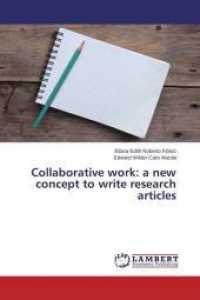- ホーム
- > 洋書
- > 英文書
- > Psychology
Full Description
An engaging and relatable examination of how we perceive and interpret the world around us
The study of human cognitive processes provides insight into why we act or react the way we do. Understanding cognition can help us understand ourselves and others and can even allow us to make educated predictions about future behaviors. In Cognition, 11th Edition, author Thomas Farmer updates this classic text with the latest advances in the field and more in-depth coverage of prominent topics. Expanded and refined throughout, this edition retains the breadth of scope and depth of detail that has made it the go-to text on the topic. Cognition emphasizes the link between conceptual cognitive psychology and real-world experience: case studies, current trends, and historical perspectives merge to provide a comprehensive understanding of core principles and theories.
Discusses behavioral measures and overviews classical behaviorist paradigms
Extends the discussions of sensory transduction, procedural memory, and more
Clarifies theories of attention and the distinction between controlled vs. automatic processing
Includes self quizzes at the end of each chapter, plus updates to all chapters with new and revised content
New to the 11th Edition:
On average, each chapter includes three or four major points of revision aimed either at better explaining a particular process or theory or at bring the examination of cognitive processes up-to-date with current science.
Practice questions for each chapter are available in formats suitable for both pen-and-paper use and digital use.
Instructor resources are enhanced with new lecture presentation slides and chapter outlines annotated by the author to facilitate lecture design and delivery.
Contents
Preface xv
1 Introduction to Cognitive Psychology 1
Chapter Introduction 1
Cognitive Psychology: Overview 1
Origins of Cognitive Psychology 4
Wilhelm Wundt 4
Early Memory Researchers 5
William James 5
Behaviorism 5
Edward Tolman 6
The Gestalt Approach 7
Cognitive Revolution 7
Cognitive Psychology More Recently 8
Perspectives on Cognitive Psychology 9
The Computer Metaphor of the Mind and Information Processing 9
The Connectionist Approach 11
Cognitive Neuroscience 12
Textbook Overview 12
Chapter Preview 13
Themes in the Book 14
Theme 1: Cognitive processes are active rather than passive 14
Theme 2: Cognitive processes are remarkably efficient and accurate 14
Theme 3: Cognitive processes handle positive information better than negative information 14
Theme 4: Cognitive processes are interrelated with one another; they do not operate in isolation 14
Theme 5: Many cognitive processes rely on both bottom-up and top-down processing 15
How to Use Your Book Effectively 15
Chapter Outline 15
Chapter Introductions 15
Demonstrations 15
"Focus on Methodology" Boxes 16
Application 16
Section Summaries 16
End of Chapter Review Questions 16
Keywords 16
Keywords List and Glossary 16
Recommended Readings 17
Section Summary Points 17
Chapter Review Questions 17
Keywords 18
Recommended Readings 18
2 Visual and Auditory Recognition 19
Chapter Introduction 19
Overview of Visual Object Recognition 20
The Visual System 20
Organization in Visual Perception 22
Theories of Visual Object Recognition 23
Feature-Analysis Theory 23
The Recognition-by-Components Theory 25
Top-Down Processing and Visual Object Recognition 28
Bottom-Up Versus Top-Down Processing 28
Top-Down Processing and Reading 29
"Smart Mistakes" in Object Recognition 30
Change Blindness 30
Inattentional Blindness 32
Specialized Visual Recognition Processes 33
Neuroscience Research on Face Recognition 33
Applied Research on Face Recognition 34
Speech Perception 36
Characteristics of Speech Perception 37
Word Boundaries 37
Variability in Phoneme Pronunciation 37
Context and Speech Perception 38
Visual Cues as an Aid to Speech Perception 38
Theories of Speech Perception 39
The Special Mechanism Approach 39
The General Mechanism Approaches 40
Section Summary Points 40
Chapter Review Questions 41
Keywords 42
Recommended Readings 42
3 Attention and Consciousness 43
Chapter Introduction 43
Overview of Attention 44
Divided Attention 44
Selective Attention 45
Dichotic Listening 45
The Stroop Effect 46
Visual Search 48
Neuroscience of Attention 50
The Orienting Attention Network 50
The Executive Attention Network 52
Theories of Attention 52
Early Theories of Attention 52
Feature-Integration Theory 53
Consciousness 55
Thought Suppression 56
Blindsight 57
Mindfulness Meditation 57
Section Summary Points 58
Chapter Review Questions 59
Keywords 59
Recommended Readings 60
4 Working Memory 61
Chapter Introduction 61
Classical Research on Short-Term Memory 62
Short-Term Memory Capacity Limits 62
The Brown/Peterson & Peterson Technique 63
The Serial-Position Effect 63
Semantic Similarity of the Items in Short-Term Memory 65
Atkinson-Shiffrin Model of Information Processing 66
The Turn to Working Memory 67
Evidence for Components with Independent Capacities 69
Phonological Loop 69
Neuroscience Research on the Phonological Loop 70
Visuospatial Sketchpad 71
Research on the Visuospatial Sketchpad 72
Neuroscience Research on the Visuospatial Sketchpad 72
Central Executive 73
Characteristics of the Central Executive 73
The Central Executive and Daydreaming 73
Neuroscience Research on the Central Executive 74
Recent Views of the Central Executive 74
Episodic Buffer 75
Applications of Working Memory 76
Working Memory and Academic Performance 76
Working Memory Abilities in Clinical Populations 77
Working Memory and Major Depression 77
Working Memory and ADHD 78
Working Memory and Generalized Anxiety Disorder 79
Summary 79
Section Summary Points 79
Chapter Review Questions 80
Keywords 81
Recommended Readings 81
5 Long-Term Memory 82
Chapter Introduction 82
Overview of Long-Term Memory 83
Encoding in Long-Term Memory 83
Levels of Processing 84
Levels of Processing and Memory for General Material 84
Levels of Processing and the Self-Reference Effect 85
Encoding-Specificity Principle 86
Research on Encoding Specificity 86
Levels of Processing and Encoding Specificity 87
Emotions Mood and Memory 88
Retrieval in Long-Term Memory 90
Explicit Versus Implicit Memory Tasks 90
Anxiety Disorders and Explicit and Implicit Memory Tasks 92
Individuals with Amnesia 92
Expertise 93
The Context-Specific Nature of Expertise 94
How Do Experts and Novices Differ? 94
Autobiographical Memory 95
Schemas and Autobiographical Memory 95
Source Monitoring and Reality Monitoring 96
Flashbulb Memories 97
Eyewitness Testimony 98
Example of Inappropriate Eyewitness Testimony 98
The Post-Event Misinformation Effect 99
Factors Affecting the Accuracy of Eyewitness Testimony 100
The Relationship Between Memory Confidence and Memory Accuracy 101
The Recovered-Memory/False-Memory Controversy 101
The Two Contrasting Positions in the Controversy 101
The Potential for Memory Errors 102
Arguments for False Memory 102
Arguments for Recovered Memory 103
Both Perspectives Are At Least Partially Correct 103
Section Summary Points 104
Chapter Review Questions 105
Keywords 105
Recommended Readings 105
6 Memory Strategies and Metacognition 106
Chapter Introduction 106
Absentmindedness and Strategies for Avoiding It 106
Memory Strategies Involving Practice and Mnemonics 108
Memory Strategies Emphasizing Practice 108
Distributed-Practice Effect 109
Testing Effect 109
Test Anxiety 110
Mnemonics Using Imagery and Organization 111
Imagery 111
Organization 112
Improving Prospective Memory 114
Comparing Prospective and Retrospective Memory 114
Absentmindedness and Prospective Memory Failures 115
Suggestions for Improving Prospective Memory 115
Metamemory 116
Accuracy of Metamemory 117
Estimating the Accuracy for Total Score Versus the Accuracy for
Individual Items 117
Estimating the Score Immediately Versus After a Delay 118
Metamemory About Factors Affecting Memory Accuracy 118
Metamemory and the Regulation of Study Strategies 119
Allocating Time When the Task Is Easy 119
Allocating Time When the Task Is Difficult 119
Conclusions About the Regulation of Study Strategies 119
Tip-of-the-Tongue and Feeling-of-Knowing Effects 120
Tip-of-the-Tongue Effect 120
Feeling of Knowing 121
Metacomprehension 121
Metacomprehension Accuracy 122
Improving Metacomprehension 123
Section Summary Points 124
Chapter Review Questions 124
Keywords 125
Recommended Readings 125
Answer to Demonstration 6.4 125
7 Mental Imagery and Cognitive Maps 126
Chapter Introduction 126
Classical Research on Visual Imagery 127
Overview of Mental Imagery 127
Mental Rotation 128
Subsequent Behavioral Research on Mental Rotation 130
The Imagery Debate 130
Cognitive Neuroscience Research on Visual Mental Imagery Tasks 131
Visual Imagery and Ambiguous Figures 132
Summary 134
Factors That Influence Visual Imagery 134
Distance and Shape Effects on Visual Imagery 134
Visual Imagery and Interference 135
Individual Differences in Mental Imagery 136
Verbalizers versus Visualizers 136
Gender Comparisons in Spatial Ability 136
Auditory Imagery 139
Auditory Imagery and Pitch 139
Auditory Imagery and Timbre 140
Cognitive Maps 140
Distance and Shape Effects on Cognitive Maps 142
Cognitive Maps and Shape 144
Relative Position Effects on Cognitive Maps 144
The Rotation Heuristic 144
The Alignment Heuristic 145
Creating a Cognitive Map 146
The Spatial Framework Model 146
The Situated Cognition Approach 147
Section Summary Points 148
Chapter Review Questions 149
Keywords 149
Recommended Readings 149
8 General Knowledge 150
Chapter Introduction 150
Background and Approaches to Semantic Memory 150
Background Information 151
Prototype Approach 152
Characteristics of Prototypes 154
Levels of Categorization 155
Conclusions About the Prototype Approach 156
Exemplar Approach 156
Comparing the Prototype and Exemplar Approaches 158
Network Models 158
The Collins and Loftus Network Model 159
Anderson's ACT-R Approach 160
The Parallel Distributed Processing Approach 161
Schemas and Scripts 165
Background on Schemas and Scripts 166
Identifying the Script in Advance 166
Memory Selection 167
Boundary Extension 168
Memory Abstraction 169
The Constructive Approach 169
The Pragmatic Approach 171
The Current Status of Schemas and Memory Abstraction 172
Memory Integration 172
The Classic Research on Memory Integration 172
Section Summary Points 173
Chapter Review Questions 173
Keywords 174
Recommended Readings 174
Answer to Demonstration 8.8 174
9 Language I: Introduction to Language and Language Comprehension 175
Chapter Introduction 175
Overview of Psycholinguistics 176
Background on Language 176
Basic Facts About Human Language 177
A Brief History of Psycholinguistics 177
Chomsky's Approach 178
Reactions to Chomsky's Theory 178
Psycholinguistic Theories That Emphasize Meaning 179
Sentence Comprehension 180
Negation 180
Syntactic Complexity 180
Lexical and Syntactic Ambiguity 182
Lexical Ambiguity 182
Syntactic Ambiguity 182
Good-Enough Processing 184
Brain and Language 185
General Considerations 185
Aphasia 185
Revisiting Broca's Area 186
Hemispheric Specialization 188
The Mirror System 189
Reading 190
Comparing Written and Spoken Language 190
Eye Movements During Reading 191
Reading Words: Theoretical Approaches 192
The Direct-Access Route 193
The Indirect-Access Route 193
Implications for Teaching Reading to Children 194
Section Summary Points 196
Chapter Review Questions 197
Keywords 197
Recommended Readings 197
Answer to Demonstration 9.1 198
10 Language II: Language Production and Bilingualism 199
Chapter Introduction 199
Language Production: Speaking 200
Producing a Word 200
Producing a Sentence 202
Producing Discourse 202
The Role of Gesture During Communication 203
Language Production: Writing 205
The Role of Working Memory in Writing 206
Planning a Formal Writing Assignment 207
Sentence Generation During Writing 207
The Revision Phase of Writing 208
Bilingualism and Second Language Learning 208
Background on Bilingualism 208
Advantages (and Minor Disadvantages) of Bilingualism 210
Second Language Learning 212
Vocabulary 212
Phonology 213
Grammar 213
Simultaneous Interpreters 214
Section Summary Points 216
Chapter Review Questions 216
Keywords 217
Recommended Readings 217
11 Problem Solving and Creativity 218
Chapter Introduction 218
Understanding the Problem 219
Methods of Representing the Problem 220
Symbols 220
Matrices 221
Diagrams 221
Visual Images 222
Perspectives on Problem Solving 222
Situated Cognition 223
Embodied Cognition 223
Problem-Solving Strategies 224
The Analogy Approach 224
The Means-Ends Heuristic 225
The Hill-Climbing Heuristic 226
Factors That Influence Problem Solving 227
Expertise 227
Mental Set 228
Functional Fixedness 229
Gender Stereotypes and Math Problem Solving 230
Problem Type: Insight Versus Noninsight Problems 231
Metacognition During Problem Solving 232
Advice About Problem Solving 232
Creativity 233
The Nature of Creativity 233
Motivation and Creativity 234
Section Summary Points 236
Chapter Review Questions 236
Keywords 237
Recommended Readings 237
Answer to Demonstration 11.3 237
Answer to Demonstration 11.5 237
Answer to Demonstration 11.6B 238
Answer to Demonstration 11.7A 238
Answer to Demonstration 11.7B 238
12 Deductive Reasoning and Decision Making 239
Chapter Introduction 239
Deductive Reasoning 240
Overview of Conditional Reasoning 240
Factors That Cause Difficulty in Reasoning 242
Biases and Deductive Reasoning 243
Belief-Bias Effect 243
Confirmation Bias 244
Heuristics and Decision Making 245
Representativeness Heuristic 246
Sample Size and Representativeness 247
Base Rate and Representativeness 247
The Conjunction Fallacy and Representativeness 248
Availability Heuristic 250
Recency and Familiarity Effects 250
The Recognition Heuristic 251
Anchoring and Adjustment Heuristic 251
Research on the Anchoring and Adjustment Heuristic 252
Estimating Confidence Intervals 253
Current Status of Heuristics and Decision Making 253
Applications of Decision-Making Research 254
Framing Effect 254
The Wording of a Question and the Framing Effect 255
Overconfidence About Decisions 256
General Studies on Overconfidence 256
Overconfidence About Completing Projects on Time 257
Reasons for Overconfidence 257
Hindsight Bias 258
Explanations for the Hindsight Bias 258
Decision-Making Style and Psychological Well-Being 259
Section Summary Points 260
Chapter Review Questions 261
Keywords 261
Recommended Readings 261
Answer to Demonstration 12.1 262
Answer to Demonstration 12.6 262
13 Cognitive Development Throughout the Lifespan 263
Chapter Introduction 263
The Lifespan Development of Memory 263
Memory in Infants 264
Memory in Children 266
Children's Working Memory 267
Children's Long-Term Memory 267
Children's Memory Strategies 269
Children's Eyewitness Testimony 271
Children's Intellectual Abilities and Eyewitness Testimony 272
Memory in Older Adults 273
Working Memory in Older Adults 273
Long-Term Memory in Older Adults 274
Explanations for Age Differences in Memory 275
The Lifespan Development of Metamemory 276
Metamemory in Children 276
Children's Understanding of How Memory Works 276
Children's Awareness That Effort Is Necessary 277
Children's Judgments About Their Memory Performance 277
Children's Metamemory: The Relationship Between Metamemory and Memory Performance 278
Metamemory in Older Adults 279
Beliefs About Memory 279
Memory Monitoring 279
Awareness of Memory Problems 280
The Development of Language 280
Language in Infants 280
Speech Perception During Infancy 281
Language Comprehension During Infancy 281
Language Production During Infancy 282
Adults' Language to Infants 283
Can Infants Learn Language from a DVD? 283
Language in Children 284
Words 284
Morphology 285
Syntax 286
Section Summary Points 286
Chapter Review Questions 287
Keywords 288
Recommended Readings 288
Glossary G-1
References R-1
Index I-1








